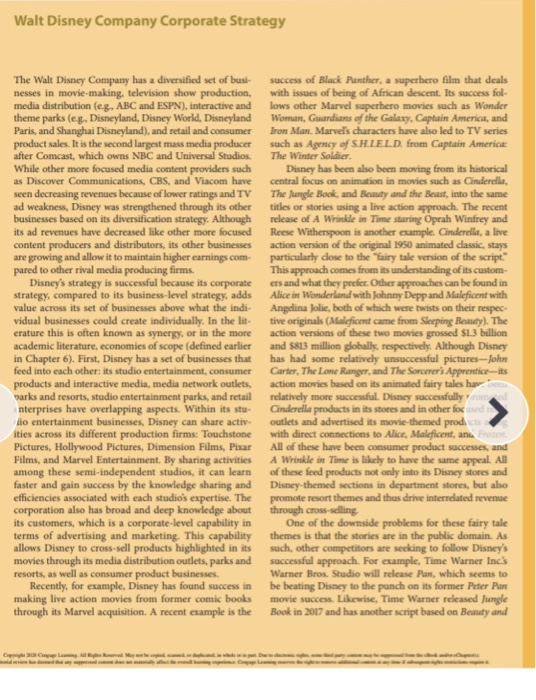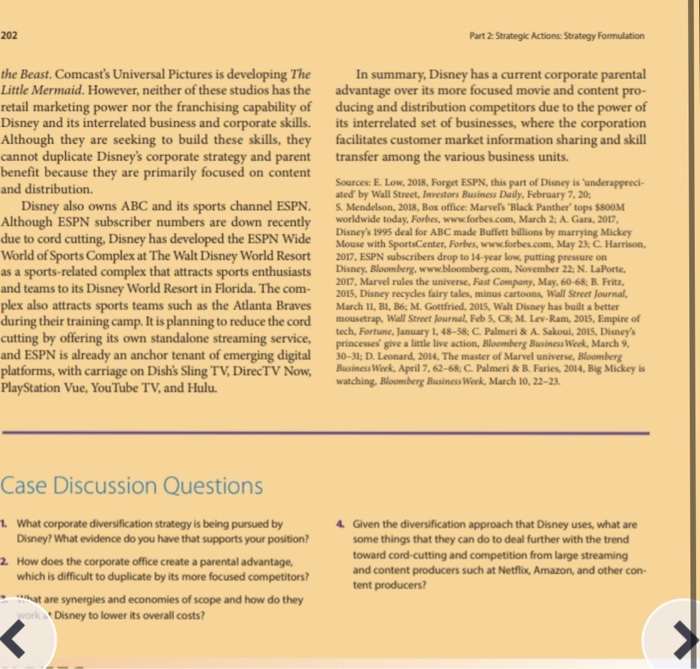What corporate-level strategy is being pursued by Disney? What evidence do you have that supports your position?
What corporate-level strategy is being pursued by Disney? What evidence do you have that supports your position?
Chapter1: Taking Risks And Making Profits Within The Dynamic Business Environment
Section: Chapter Questions
Problem 1CE
Related questions
Question
- What corporate-level strategy is being pursued by Disney? What evidence do you have that supports your position?

Transcribed Image Text:Walt Disney Company Corporate Strategy
The Walt Disney Company has a diversified set of busi-
nesses in movie-making, television show production,
media distribution (eg, ABC and ESPN), interactive and
theme parks (eg. Disneyland, Disney World, Disneyland
Paris, and Shanghai Disneyland), and retail and consumer
product sales. It is the second largest mass media producer
after Comcast, which owns NBC and Universal Studios.
success of Black Panther, a superhero film that deals
with issues of being of African descent. Its success fol-
lows other Marvel superhero movies such as Wonder
Woman, Guardians of the Galaxy, Captain America, and
Iron Man. Marvels characters have also led to TV series
such as Agency of S.H.LE.L.D. from Captain America
The Winter Soldier.
While other more focused media content providers such
as Discover Communications, CBS, and Viacom have
Disney has been also been moving from its historical
central focus on animation in movies such as Cinderella,
seen decreasing revenues because of lower ratings and TV
ad weakness, Disney was strengthened through its other
businesses based on its diversification strategy. Although
its ad revenues have decreased like other more focused
The Jungle Book, and Beauty and the Beast, into the same
titles or stories using a live action approach. The recent
release of A Wrinkle in Time staring Oprah Winfrey and
Reese Witherspoon is another example. Cinderella, a live
action version of the original 1950 animated classic, stays
particularly close to the "fairy tale version of the script"
This approach comes from its understanding of its custom-
ers and what they prefer. Other approaches can be found in
Alice in Wonderland with Johnny Depp and Maleficent with
Angdina Jolie, both of which were twists on their respec-
tive originals (Maleficent came from Sleeping Beauty). The
action versions of these two movies grossed $13 bllion
and $813 million globally, respectively. Although Disney
has had some relatively unsuccessful pictures-John
Carter, The Lone Ranger, and The Sorcerer's Apprentice-its
action movies based on its animated fairy tales hav bee
relatively more successful. Disney successfully
Cinderella products in its stores and in other foc sed r
outlets and advertised its movie-themed prodcts
with direct connections to Alice, Maleficent, an Frocen
All of these have been consumer product successes, and
A Wrinkle in Time is likely to have the same appeal. All
of these feed products not only into its Disney stores and
Disney-themed sections in department stores, but also
promote resort themes and thus drive interrelated revenue
through cross-selling
One of the downside problems for these fairy tale
themes is that the stories are in the public domain. As
such, other competitors are seeking to follow Disney's
successful approach. For example, Time Warner Inc'
Warner Bros. Studio will release Pan, which seems to
content producers and distributors, its other businesses
are growing and allow it to maintain higher earnings com-
pared to other rival media producing firms.
Disney's strategy is successful because its corporate
strategy, compared to its business-level strategy, adds
value across its set of businesses above what the indi-
vidual businesses could create individually. In the lit-
erature this is often known as synergy, or in the more
academic literature, economies of scope (defined earlier
in Chapter 6). First, Disney has a set of businesses that
feed into each other: its studio entertainment, consumer
products and interactive media, media network outlets,
parks and resorts, studio entertainment parks, and retail
nterprises have overlapping aspects. Within its stu-
lio entertainment businesses, Disney can share activ-
ities across its different production firms: Touchstone
Pictures, Hollywood Pictures, Dimension Films, Pixar
Films, and Marvel Entertainment. By sharing activities
among these semi-independent studios, it can learn
faster and gain success by the knowledge sharing and
efficiencies associated with each studio's expertise. The
corporation also has broad and deep knowledge about
its customers, which is a corporate-level capability in
terms of advertising and marketing. This capability
allows Disney to cross-sell products highlighted in its
movies through its media distribution outlets, parks and
resorts, as well as consumer product businesses.
Recently, for example, Disney has found success in
making live action movies from former comic books
through its Marvel acquisition. A recent example is the Book in 2017 and has another script based on Beauty and
be beating Disney to the punch on its former Peter Pan
movie success. Likewise, Time Warner released Jungle
C Cn lang M

Transcribed Image Text:202
Part 2 Strategic Actions: Strategy Formulation
the Beast. Comcast's Universal Pictures is developing The
Little Mermaid. However, neither of these studios has the
retail marketing power nor the franchising capability of
Disney and its interrelated business and corporate skills.
Although they are seeking to build these skills, they
cannot duplicate Disney's corporate strategy and parent
benefit because they are primarily focused on content
and distribution.
In summary, Disney has a current corporate parental
advantage over its more focused movie and content pro-
ducing and distribution competitors due to the power of
its interrelated set of businesses, where the corporation
facilitates customer market information sharing and skill
transfer among the various business units.
Disney also owns ABC and its sports channel ESPN.
Although ESPN subscriber numbers are down recently
due to cord cutting, Disney has developed the ESPN Wide
World of Sports Complex at The Walt Disney World Resort
as a sports-related complex that attracts sports enthusiasts
and teams to its Disney World Resort in Florida. The com-
plex also attracts sports teams such as the Atlanta Braves
during their training camp. It is planning to reduce the cord
cutting by offering its own standalone streaming service,
and ESPN is already an anchor tenant of emerging digital
platforms, with carriage on Dish's Sling TV, DirecTV Now,
PlayStation Vue, YouTube TV, and Hulu.
Sources: E. Low, 2018, Forget ESPN, this part of Disney is 'underappreci-
ated by Wall Street, Investors Business Daily, February 7, 20;
S. Mendelson, 2018, Box office: Marvel's "Black Panther tops $800M
worldwide today, Forbes, www.forbes.com, March 2; A. Gara, 2017.
Disney's 1995 deal for ABC made Buffett billions by marrying Mickey
Mouse with SportsCenter, Forbes, www.forbes.com, May 23; C. Harrison,
2017, ESPN subscribers drop to 14-year low, putting pressure on
Disney. Bloomberg, www.bloomberg.com, November 22: N. LaPorte,
2017, Marvel rules the universe, Fast Company, May, 60-68; B. Fritz,
2015, Disney recycles fairy tales, minus cartoons, Wall Street Journal,
March 11, BI, B6; M. Gottfried, 2015, Walt Disney has built a better
mousetrap, Wall Street Journal, Feb 5, C8; M. Lev-Ram, 2015, Empire of
tech, Fortune, January 1, 48-58; C. Palmeri & A. Sakoui, 2015, Disney's
princesses' give a little live action, Bloomberg Business Week, March 9.
30-31; D. Leonard, 2014, The master of Marvel universe, Bloomberg
Business Week, April 7, 62-68; C. Palmeri & B. Faries, 2014, Big Mickey is
watching, Bloomberg Business Week, March 10, 22-23.
Case Discussion Questions
1. What corporate diversification strategy is being pursued by
Disney? What evidence do you have that supports your position?
4. Given the diversification approach that Disney uses, what are
some things that they can do to deal further with the trend
toward cord-cutting and competition from large streaming
and content producers such at Netflix, Amazon, and other con-
tent producers?
2 How does the corporate office create a parental advantage,
which is difficult to duplicate by its more focused competitors?
- at are synergies and economies of scope and how do they
worka Disney to lower its overall costs?
Expert Solution
This question has been solved!
Explore an expertly crafted, step-by-step solution for a thorough understanding of key concepts.
This is a popular solution!
Trending now
This is a popular solution!
Step by step
Solved in 2 steps

Knowledge Booster
Learn more about
Need a deep-dive on the concept behind this application? Look no further. Learn more about this topic, management and related others by exploring similar questions and additional content below.Recommended textbooks for you

Understanding Business
Management
ISBN:
9781259929434
Author:
William Nickels
Publisher:
McGraw-Hill Education

Management (14th Edition)
Management
ISBN:
9780134527604
Author:
Stephen P. Robbins, Mary A. Coulter
Publisher:
PEARSON

Spreadsheet Modeling & Decision Analysis: A Pract…
Management
ISBN:
9781305947412
Author:
Cliff Ragsdale
Publisher:
Cengage Learning

Understanding Business
Management
ISBN:
9781259929434
Author:
William Nickels
Publisher:
McGraw-Hill Education

Management (14th Edition)
Management
ISBN:
9780134527604
Author:
Stephen P. Robbins, Mary A. Coulter
Publisher:
PEARSON

Spreadsheet Modeling & Decision Analysis: A Pract…
Management
ISBN:
9781305947412
Author:
Cliff Ragsdale
Publisher:
Cengage Learning

Management Information Systems: Managing The Digi…
Management
ISBN:
9780135191798
Author:
Kenneth C. Laudon, Jane P. Laudon
Publisher:
PEARSON

Business Essentials (12th Edition) (What's New in…
Management
ISBN:
9780134728391
Author:
Ronald J. Ebert, Ricky W. Griffin
Publisher:
PEARSON

Fundamentals of Management (10th Edition)
Management
ISBN:
9780134237473
Author:
Stephen P. Robbins, Mary A. Coulter, David A. De Cenzo
Publisher:
PEARSON